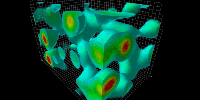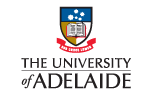Role of the Wilson mass parameter in the overlap Dirac topological charge density
Peter Moran, CSSM
3.30pm, Physics Seminar Room 121,
Physics Building, The University of Adelaide.
The negative Wilson mass parameter is an input parameter to the
overlap Dirac operator. We examine the extent to which the
topological charge density, revealed by the overlap definition,
depends on the value of the negative Wilson mass. A strong
dependence is observed, which can be correlated with the topological
charge density obtained from the gluonic definition, with a variable
number of stout-link smearing sweeps. The results indicate that the
freedom typically associated with fat-link fermion actions, through
the number of smearing sweeps, is also present in the overlap
formalism, through the freedom in the Wilson mass parameter.
The Weinberg angle and possible new physics beyond the Standard Model
Prof. Tony Thomas, CSSM
3.30pm, Physics Seminar Room 121,
Physics Building, The University of Adelaide.
We outline recent progress in constraining possible new physics
through the study of parity violation in both electron and neutrino
scattering.
Click here for a pdf of this presentation
Excited States of the Nucleon in Lattice QCD
Selim Mahbub, CSSM
3.30pm, Physics Seminar Room 121,
Physics Building, The University of Adelaide.
We present an overview of the correlation-matrix methods for the
isolation of excited states of the nucleon. Of particular interest is
the first positive-parity excited-state of the nucleon known as the
Roper resonance (1440 MeV). Using eigen-vectors of the correlation
matrix we construct parity and eigenstate projected correlation
functions which are analysed using standardised methods. The robust
nature of this approach for extracting the eigenstate energies will be
presented. Using several different approaches for constructing basis
interpolators, we demonstrate how improving the basis can split what
otherwise might be interpreted as a single state into multiple
states. We report the importance of using a variety of source and sink
smearings in achieving this. In particular we consider $2\times 2$,
$3\times 3$, $4\times 4$, $6\times 6$ and $8\times 8$ correlation
matrices built from a variety of interpolators and smearing levels. We
report a low-lying Roper state for the first time contrasting earlier
results using correlation matrices. We also observe a level crossing
between the Roper and $N^{{\frac{1}{2}}^{-}}$ (1535 MeV)
states. Finally we present our preliminary Roper results from
dynamical QCD and both the dynamical and quenched QCD results are in
very good agreement.
Click here for a pdf of this presentation
Hybrid Monte Carlo for Lattice QCD
Dr. Waseem Kamleh, CSSM
3.30pm, Physics Seminar Room 121,
Physics Building, The University of Adelaide.
This will be a pedagogical talk on the Hybrid Monte Carlo (HMC)
algorithm as applied to lattice QCD. HMC is the standard method used
to generate gauge field configurations that include the contribution
of dynamical fermions.
|





